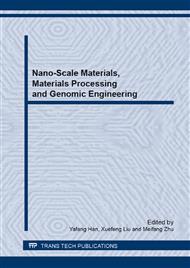[1]
E.J. Lavernia, N.J. Grant. Spray deposition of metals: a review, J. Materials Science and Engineering. 98 (1988) 381-394.
DOI: 10.1016/0025-5416(88)90191-7
Google Scholar
[2]
E.J. Lavernia, and Y. Wu, Spray atomization and deposition, John Wiley, New York , 1996.
Google Scholar
[3]
G.Q. Zhang, Z. Li, S.F. Tian, and M.G. Yan, A unique spray forming process for high temperature materials for aerospace applications, J. ICAS 2002.
Google Scholar
[4]
R. Gjesing, J. Hattel, and U. Fritsching, Coupled atomization and spray modeling in the spray forming, J. Engineering Applications of Computational Fluid Mechanics. 3.4 (2009) 471-486.
DOI: 10.1080/19942060.2009.11015284
Google Scholar
[5]
J. Ting, I. E. Anderson, A coumputational fluid dynamics (CFD) investigation of the wake closure phenomenon, J. Materials Science and Engineering: A. 379.1 (2004) 264-276.
DOI: 10.1016/j.msea.2004.02.065
Google Scholar
[6]
C. Czisch and U. Fritsching, Atomizer design for viscous-melt atomization, J. Material Science and Engineering: A. 477 (2008) 21-25.
DOI: 10.1016/j.msea.2007.06.087
Google Scholar
[7]
N. Zeoli and S. Gu., Computational simulation of metal droplet break-up, cooling and solidification during gas atomization, J. Computational Materials Science, 43 (2008) 268-278.
DOI: 10.1016/j.commatsci.2007.10.005
Google Scholar
[8]
Udo Fritsching. Droplets and particles in sprays: tailoring particle properties within spray process, J. China Particuology. 3 (2005) 125-133.
DOI: 10.1016/s1672-2515(07)60178-x
Google Scholar
[9]
J. Mi, P.S. Grant, U. Fritsching, O. Belkessam, I. Garmendia and A. Landaberea. Multiphysics modelling of the spray forming process, J. Material Science and Engineering: A. 477 (2008) 2-8.
DOI: 10.1016/j.msea.2007.08.083
Google Scholar
[10]
J. Heinlein, G. Schulte, U. Fritsching and R. Guardani, Mapping the structure of a liquid spray by means of neural networks, J. Chemical Engineering and processing. 46 (2007) 1357-1364.
DOI: 10.1016/j.cep.2006.10.019
Google Scholar
[11]
Jason Ting, Michael W. Peretti, and William B. Eisen, The effect of wake-closure phenomenon on gas atomization performance, J. Materials Science and Engineering: A. 326 (2002) 110-121.
DOI: 10.1016/s0921-5093(01)01437-x
Google Scholar
[12]
N. Zeoli and S. Gu. Computational validation of an isentropic plug nozzle design for gas atomization, J Computational Materials Science, 42 (2008) 245-258.
DOI: 10.1016/j.commatsci.2007.07.013
Google Scholar


